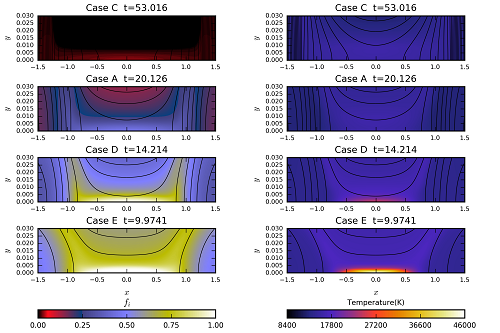Recently,a paper published by The Astrophysical Journal has reported the new progress about magnetic reconnection mechanism in the low solar atmosphere. This work is achieved by Dr. Lei Ni et al., an associate research fellow of the Solar physics group of Yunnan Observatories (YNAO), Chinese Academy of Sciences (CAS). For the first time, the reactive multi-fluid plasma-neutral model has been applied to study magnetic reconnection in strongly magnetized and weakly ionized plasma around the solar temperature minimum region (TMR). The research results further reveal the physical mechanism of the small scale brightening events observed both by the Interface Region Imaging Spectrograph (IRIS) satellite and the ground-based high resolution Solar telescopes. They can help to answer the interesting but currently controversial issue “Is that possible for the plasma temperature around the Solar TMR to be heated high enough to produce the Si IV emission lines? Are there any connections between the IRIS bursts (IBs) and the traditional Ellerman Bombs (EBs) ? ”
EBs were originally identified as regions of intense brightness in the blue and red wings of the Hαline profile. They are usually formed by magnetic reconnection from the top photosphere to the low chromosphere. From the observational experiences and traditional EB models, the measured temperature in EBs is usually lower than 10000 K. Recently, the joint observations between the IRIS satellite and the ground-based high resolution Solar telescopes have discovered some new bursts which have similar characteristics as the traditional EBs (e.g., similar life time, size and so on), but a plasma temperature which is at least higher than 20000 K is required to produce the Si IV emission lines inside these events around the high density Solar TMR region.
The previous one-fluid simulations showed that the plasma temperature can only be heated to be about 10000 K in a magnetic reconnection process in the low solar chromosphere. However, the artificial anomalous resistivity was applied and the resolutions were very low in those simulations. Ni et al 2015, 2016 have performed high resolution MHD simulations with a more realistic resistivity included. They found that the plasma temperature was heated from 4200 K to be above 80000 K in the magnetic reconnection process with magnetic fields of 500 G around the Solar TMR region. However, the plasmas were always assumed in equilibrium ionization-recombination state in all the one-fluid simulations.
The multi-fluid plasma-neutral model applied in this research has considered the more realistic non-equilibrium ionization-recombination effect and resistivity, the charge exchange, Hall effect, radiative cooling, heat conduction and viscosity effects have also been included. They find that the non-equilibrium ionization-recombination leads to much lower temperature increase, the high temperature increase in their previous one-fluid simulations was overestimated. However, when the reconnecting magnetic field is in excess of a kilogauss, the initially weakly ionized plasmas can become fully ionized within the reconnection region and the current sheet is strongly heated to a temperature above 20000 K. Therefore, the Si IV emission lines can still possibly be produced. Their results also show that the ionization rate is always faster than the recombination rate in the strongly magnetized low β magnetic reconnection process, and the variation of the reconnection rate is similar as in fully ionized plasma. The strong recombination rate leads to a much faster reconnection rate than that in fully ionized plasma in the high β magnetic reconnection process.
The plasma environment around the Solar TMR is very complicated. The magnetic reconnection model in the work by Ni et al. has included the most physical effects, and their results are also at the leading-edge in this field. The series of works by the team of Ni et al. are very important for understanding the physical mechanisms of magnetic reconnection in the partially ionized plasmas and the small scale events in the low solar atmosphere.
This research is supported by the NSFC Grants 11573064, 11203069 and 11333007; the Western Light of Chinese Academy of Sciences 2014; the Youth Innovation Promotion Association CAS 2017; and the Special Program for Applied Research on Super Computation of the NSFC-Guangdong Joint Fund.

Figure.1 The distributions of the ion and neutral temperatures across the current sheet through the reconnection X-point. The non-equilibrium ionization-recombination effect is inlcuded in Case A ; the plasma is artificially assumed in equilibrium ionization-recombination state in Case A0. We can see that it is very important to include the non-equilibrium ionization-recombination effect from this figure.(Image by NI)

Figure.2 The 2D distributions of the ionization fraction fi and the plasma temperature inside the current sheet around the Solar TMR in different cases with different magnetic fields. The strengths of the magnetic fields are 100 G, 500 G, 1000 G and 1500 G in Case C, A, D and E, respectively.(Image by NI)
Contact:
NI Lei
Yunnan Observatories, Chinese Academy of Sciences
email: leini@ynao.ac.cn,
Phone: 0871-63920142